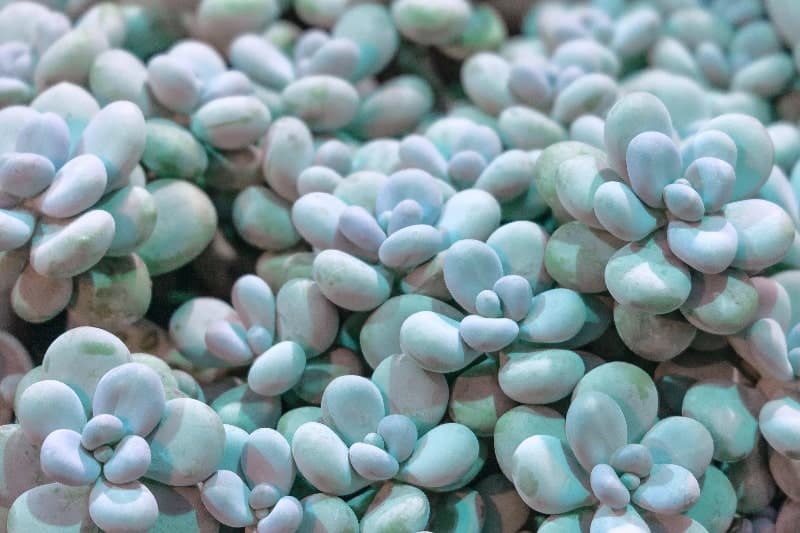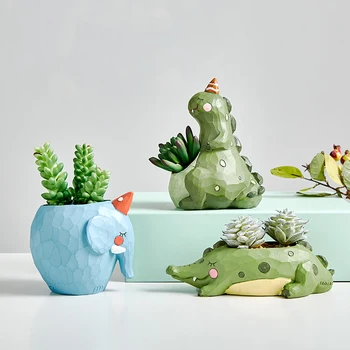As the name implies, the Moonstone Succulent (Pachyphytum Oviferum) is a succulent plant. As a member of the Crassulaceae family of plants, Moonstone is incredibly easy to care for and is best suited for plant parents who are just starting.
In this article, we will introduce how to grow the care for moonstone succulent.
Moonstone succulent is a medium-sized plant originating from the Mexican mountains. It features small almond-shaped, juicy leaves while being about 4 inches tall and 12 inches wide.
This gorgeous houseplant grows in interesting colors, ranging from grays, blues, and purples to yellows, oranges, and pinks. Bell-shaped flowers start growing on the Moonstone Succulent in clusters during the winter season.
The greenish-white and beige/pink/orange flowers make the Moonstone a unique succulent. Its gorgeous aesthetics will make for a beautiful addition to your home.

The Pachyphytum Oviferum can survive in various growing conditions, making it an excellent beginner plant. While it doesn’t demand much care, there are a few things you must care about to ensure the healthy growth of your chubby Succulent.
Your moonstone succulent thrives in full and partial sunlight, staying much healthier in well-lit environments.
A Moonstone succulent typically requires a temperature of at least 30° F., So it’s not a plant that thrives or even survives in low temperatures.
While it will love a sunny spot, shield your plant from the harsh sunlight on extremely hot summer days. Conversely, you want to keep your Succulent indoors when freezing outside.
Like other succulent plants, you do not need to water a Moonstone Succulent very often. Let the soil dry out before you water it again. You can also tell if your Moonstone needs water if the leaves feel soft to the touch.
Moonstone succulents are easy to grow and care for in pots. But, the pot choice makes a huge difference in how well it thrives. Terracotta and clay pots with drainage holes are a better choice. These potting options reduce the risk of overwatering. Remember that overwatering your plant can cause the roots to rot over time.
The holes at the bottom of the pot allow excess water to flow out. And clay allows penetration of moisture and air. You will need to be more careful with terracotta pots. They tend to release moisture faster and at higher temperatures.
Moonstones do not prefer their soil to remain wet for long, so a well-draining soil mix is ideal. A cactus mix with 50% to 70% mineral grit like perlite, pumice, and sand is best.
Your Moonstone Succulent will not give you a hard time when it comes to pests and diseases. But, insects like mealybugs can still occasionally harm this otherwise disease-resistant plant. Your Moonstone Succulent may stop growing due to a Mealybug infestation.
Moonstone Succulents can thrive outdoors unless temperatures fall below -45°C during winters. If it freezes after growing well, you can restore any damage by covering its base up with warm towels.
This makeshift blanket will protect your Moonstone from harsh weather conditions. Nonetheless, keep it away from direct sunlight if you’re growing your plant outdoors.
You will need to protect your Moonstone Succulent from extreme weather changes if temperatures in your region fall to dangerous levels.
You can place your plant near a fireplace to prevent it from getting too humid or dry. Wrapping a makeshift blanket around Moonstone’s base allows air circulation, and it will protect from root rot.
You can easily and quickly propagate a Moonstone Succulent plant by following these steps:
Make sure to remove the entire leaf from its base to the stem.
After almost a month, pink-colored roots will begin to grow from the cut, with a new rosette growing at its base.

Endemic to Mexico, the Moonstone Succulent plant is a rare type of succulent. It features chubby leaves with a layer of white powder. Moonstone Succulents grow in various colors, including green, bronze, purple, and pink, with pink Moonstone being the most popular type.
Moonstone Succulent prefers to grow in plenty of light and thrives well in full to partial sunlight. Although it loves a sunny spot, avoid placing it in direct sunlight as the harsh rays from the sun can damage Moonstone’s leaves. Partial sunlight works best for Moonstone Succulent.
Moonstone Succulent is typically a medium-sized plant with small, pebble-shaped leaves. It can grow up to 4 inches high and 12 inches wide if taken care of.
According to the ASPCA’s list of non-toxic plants, Moonstone Succulents are harmless to pets like cats and dogs. However, ingesting a lot of the leaves can cause vomiting. However, don’t worry. Checking in with a vet will help you avoid any complications.
Moonstone Succulent or Pachyphytum Oviferum is easy to care for. It does not demand excessive watering, and you can easily and quickly propagate it from cuttings. Besides, it can also thrive well in extremely hot and cold temperatures.
You may enjoy these related articles:




We provide a platform supported by gardening enthusiasts to share unique experience and knowledge.
We’ve pledged 5% of sales to the program which help more families have opportunity to have garden.
Every action we make has an impact on planet. Learn more about Million Compost Movement.
Join facebook community to connect, share passion and get support when you need.
Keep in mind that we may receive commissions when you click our links and make purchases. However, this does not impact our reviews and comparions. We try our best to keep things fair and balanced, in order to help you make the best choice for you.
As an Amazon Associate, we earn from qualifying purchases.
Sign up for gardening tips, activism awareness, exclusive offers and more!
© Garden Guidepost

Gardening tips, activism awareness, exclusive offers and more!